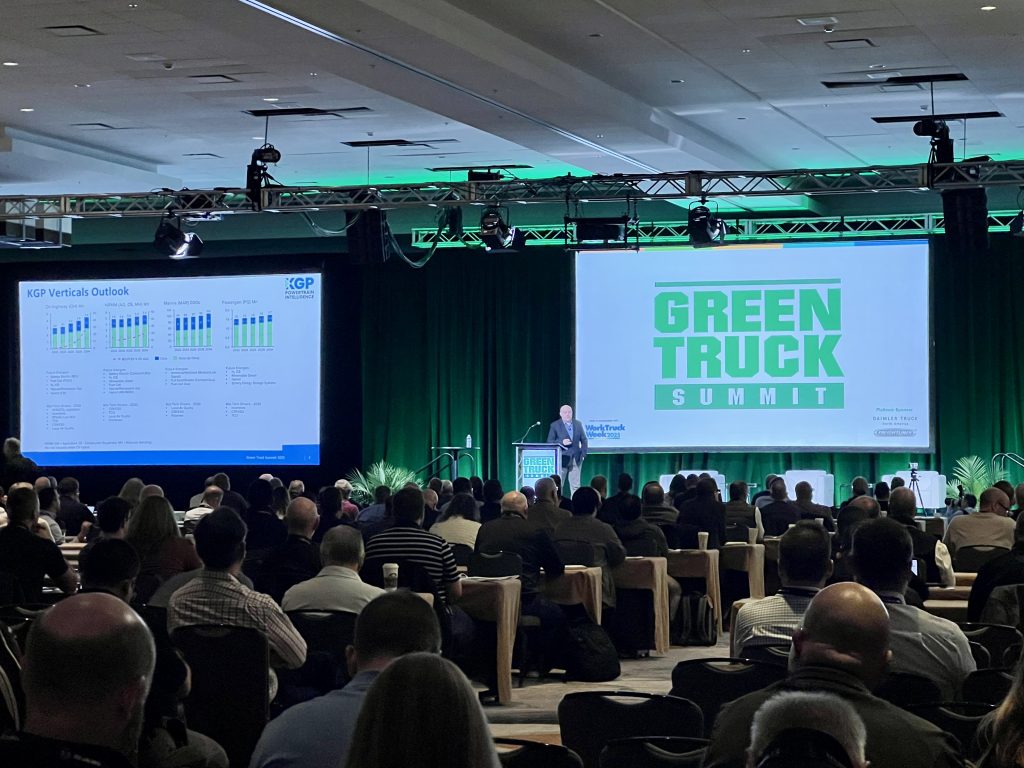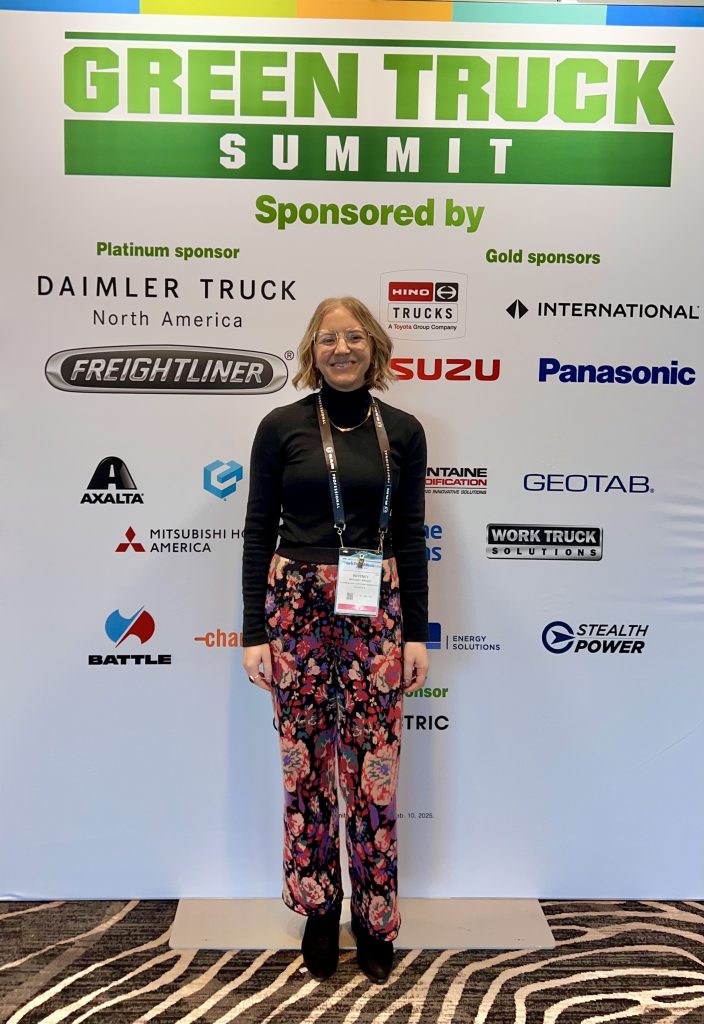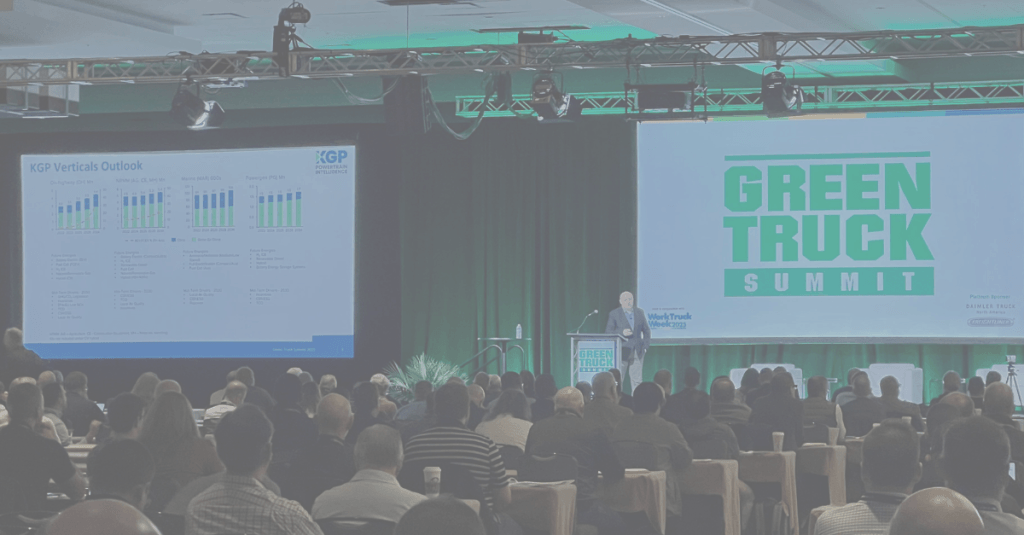Green Truck Summit, held at the beginning of Work Truck Week, annually delivers valuable insights, solutions, and resources to support the work truck industry’s push for greater sustainability, productivity, and efficiency. Held on Tuesday, March 4, 2025, at the JW Marriott in Indianapolis, the summit featured in-depth sessions led by industry experts, exploring both applied and emerging advanced vehicle and fuel technologies within the commercial vehicle sector.
This year, attendees had the pleasure of hearing the keynote address from Jennifer Brace, Chief Futurist for Ford Motor Company, amongst other sessions about zero-emissions, advancing technology adoption, and autonomous technology insights.
Keynote: Thinking Like a Futurist
In a rapidly evolving world, understanding the future requires balancing trends and uncertainty. Brace spent her keynote address helping attendees learn how to think like a futurist, or someone who studies the present and upcoming trends to make predictions about the future. While trends rely on data and observable cues to predict what’s coming next, uncertainty involves recognizing the signposts that indicate whether things are moving in a favorable or challenging direction. Brace taught that thinking like a futurist means imagining multiple versions of the future and preparing for all possibilities.
Additionally, she touched on how artificial intelligence is here to stay, and its growth is inevitable. Rather than resisting change, the key is to engage with AI by asking the right questions: How is it being used? What impact will it have on your industry? She encouraged businesses to embrace AI to help navigate an increasingly automated landscape.
Achieving Zero-Emission Targets: Real-World Strategies and Key Takeaways for the Commercial Vehicle Industry
After the keynote, John Davis, Managing Director of MotorWeek, moderated the next session while Alex Woodrow, Managing Director of Knibb, Gormezano and Partners presented. Woodrow noted how transitioning to zero emissions requires a multifaceted approach beyond just electric vehicles. As we have seen, several states are following California’s emission standards, accelerating clean fuel adoption. However, it is important to keep in mind that no single low- or zero-emission fuel meets all needs.
In the U.S., zero-emission vehicle registrations still account for less than 2% of total registrations, increasing from 2,000 to 13,000 between 2022 and 2023. As the commercial sector moves toward sustainability, commercial powertrains are expected to adopt a variety of low-carbon fuels.

Several key factors are influencing the adoption of zero-emission vehicles. Legislation and regulatory policies play a pivotal role, driving industry standards and setting clear mandates for reducing emissions. Original Equipment Manufacturers (OEMs) are also making significant commitments to producing zero-emission vehicles, aligning their strategies with sustainability goals. Infrastructure development is critical, as the expansion of charging networks and refueling stations is necessary to support the widespread use of zero-emission vehicles.
Additionally, the Total Cost of Ownership (TCO) remains a major consideration for consumers and businesses, with long-term savings on fuel and maintenance often outweighing higher upfront costs. Finally, access to critical materials such as batteries and other components is essential to meet demand and ensure the scalability of zero-emission technologies.
While renewable diesel is expanding, its growth is concentrated in states with Clean Fuel Programs. The best greenhouse gas (GHG) savings don’t just rely on fuel choices—they must also consider productivity, ensuring that reductions aren’t achieved at the expense of efficiency. Work trucks, with their typically shorter distances, present unique opportunities for cost savings through Total Cost of Ownership (TCO), while longer distances and power needs may benefit from hybrid solutions. Ultimately, collaboration across stakeholders is essential to ensure the development of the most effective and efficient charging and EV infrastructure.
Advancing Technology Adoption
After lunch, an industry roundtable was hosted on how to move technology adoption forward in the commercial truck industry. Moderated by Andrew Wrobel, Commercial Vehicle Insight Strategist at NTEA, the session included a panel discussion by Scott Brower, Vice President, Vehicle Supply of New Products and Vehicle Applications for Penske Truck Leasing; Mark Dickens, Vehicle Chief Engineer of Next-Gen HD/MD ZEV Trucks at General Motors; Chris Hayes, Chassis Development Engineer at Altec; and Mark Ronnebaum, General Manager at Olathe Ford Commercial.
The panelists discussed how one of the biggest challenges facing businesses with technology is cost, particularly when it comes to driver adoption, training, and maintenance. The expenses associated with integrating new technologies can be significant, requiring a considerable investment in both equipment and workforce readiness. Over the next few years, software and powertrain innovations are expected to have the most profound impact on the industry, driving improvements in efficiency and sustainability.
Regulations will likely play a crucial role in accelerating the adoption of advanced vehicle technologies in the commercial sector, pushing companies to upgrade their fleets to meet environmental and performance standards. The work truck industry will undoubtedly require vehicles with more advanced technology, as these innovations will help improve productivity, reduce emissions, and enhance overall fleet management.
Emerging Technology: Hydrogen Applications and Use Cases in Work Trucks
One of the two breakout sessions after the industry roundtable was about hydrogen use cases in work trucks. Presented by Ben Playfoot, Segment Lead on Electrification for AVL Mobility Technologies, he discussed the potential of hydrogen combustion engines (HCE) and fuel cell electric vehicles (FCEV).
Playfoot drove home how these two technologies are viable, sustainable fuel options for commercial vehicles and work trucks. He more specifically focused on how hydrogen is gaining traction as an alternative fuel for heavy-duty applications, as it has more power than battery electric vehicles.
Attendees explored hydrogen storage solutions, gained valuable insights into the latest advancements and practical applications, and discovered how hydrogen can play a key role in shaping the future of the evolving commercial vehicle industry.
Charge Ahead at Scale: How Connected Vehicle Technologies Can Conquer the Top 3 Challenges of Fleet Electrification (Panasonic Fleet Solutions)
In a breakout session later in the day, Panasonic discussed the three primary challenges of fleet electrification: infrastructure readiness, financial viability, and operational integration.
Presented by Panasonic Smart Mobility’s Head of Engineering for EV Fleet Solutions Hadi Hajimiri, he went into depth about the three challenges of fleet electrification: infrastructure readiness, financial visibility, and operational integration.
Regarding infrastructure readiness, Hajimiri presented on infrastructure readiness concerning grid capacity, the availability of charging locations, and the reliability of the charging network. Financial visibility, the second point of pain in fleet electrification, includes high upfront costs, unclear return on investment (ROI), and a lack of sufficient incentives. Lastly, operational integration presents a hurdle, as the complexity of the transition, managing mixed fleets, and addressing training gaps make the shift difficult.
Panasonic addressed these challenges by offering solutions such as financial modeling with Total Cost of Ownership (TCO) calculators, transition timelines, and incentive mapping. Hajimiri also focused on infrastructure optimization, helping with charging site selection and grid assessment. Additionally, he noted that Panasonic provides seamless integration for mixed-fleet management, telematics, and driver training.
A real-life example of fleet electrification done right is City of Fort Collins, Colorado, which these challenges by analyzing charging practices using managed charging software, evaluating the feasibility of incorporating charging management into their existing Distributed Energy Resource Management System (DERMS) platform, and assessing the potential cost savings to determine ratepayer value.
Green Truck Summit 2026

Green Truck Summit 2025 was full of insights, valuable information and data, and knowledgeable speakers from across the work truck industry. The discussions throughout the day highlighted the importance of adaptability, innovation, and collaboration in navigating the evolving landscape of commercial transportation. From zero-emission strategies to hydrogen applications and fleet electrification, the industry is at a pivotal moment where technology, policy, and market dynamics must align for meaningful progress.
As businesses and policymakers work toward a cleaner, more efficient future, the insights shared in these sessions underscore the need for strategic planning and cross-industry cooperation. By staying informed, leveraging emerging technologies, and fostering a forward-thinking mindset, stakeholders can drive sustainable change and lead the transition to a more resilient transportation sector.
Green Truck Summit is set to return in 2026 during Work Truck Week, which operates March 10-13, 2026, in Indianapolis, Indiana.

Whitney began working with IACT in 2023. With a degree in English and a minor in Art, Whitney has worked as both a newspaper reporter and a digital marketing and events manager, bringing 7 years of marketing and 8 years of content creation experience to IACT. Whitney is passionate about nature and preserving the environment, including solutions to cleaner air and greater sustainability, and is a former Chicago resident.



